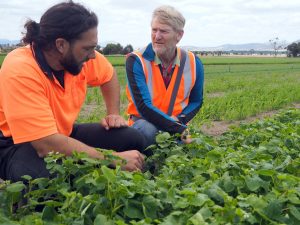New cover cropping resource for vegetable growers
Vegetable growers across the country are turning to cover crops to improve their soil. To help growers, Applied Horticultural Research (AHR) has put together the ‘Cover Crops for Australian Vegetable Growers’ poster, which you will have received with this issue of Vegetables Australia. Dr Kelvin Montagu from AHR explains why this poster has been created, and how to use it.
Finding new information on cover crops requires sifting through websites and factsheets looking for key details such as sowing rates.
However, the project team involved in Optimising cover cropping for the Australian vegetable industry – a strategic levy investment under the Hort Innovation Fund – has done the hard work for growers. The team has put together a poster summarising information on 48 cover crops suited to vegetable growing in Australia.
The poster, released alongside this edition of Vegetables Australia, provides a starting point for helping you choose a cover crop for your farm. Growers can adapt the information within the table to suit their farming operations, climate and cover crop objective and look for local guidance on suitable varieties for your conditions.

About the poster
With many people getting their information about cover crops from overseas websites, AHR wanted to bring together Australian information relevant to vegetable growers.
The poster provides a summary of the relative benefits of cover crops including protecting soil and adding biomass, suppressing weeds, adding nitrogen, recovering nutrients and any biofumigation activity.
The growth tolerances and soil conditions columns will help you choose cover crops suited to your conditions.
Choosing cover crops well-suited to the conditions is important. But remember, to get the most out of your cover crops, you need to treat them like a crop by sowing at the right time, avoiding main pest and disease periods, and giving them adequate nutrition and water.
Practical information is provided on sowing rates, and when to adjust the rates to suit your objective and your sowing gear and conditions.
Information for the poster has been pulled together from trials around Australia, along with publications and grower and researcher experience. A big thank you to the many growers who shared their experiences with the teams from Applied Horticulture Research, the Department of Agriculture and Fisheries, Queensland, Tasmania Institute of Agriculture and the University of New England.
Additional information
Growers are also advised to keep an eye out for these tables:
Cover Crops and Soil-borne Diseases, which summarises which cover crops make common soil-borne diseases better or worse after their growth compared to a fallow; Cover Crops and Termination, which summarises information on termination options and how long the cover crop biomass might stick around for; and Cover Crops and Herbicides, which summarises the potential impact of herbicides used in common summer or winter grown vegetable crops along with their potential impact on the cover crop, and potential herbicides that can be used on cover crops.
We hope to see the poster on your shed wall next time we visit.
Find out more
For more information on cover crops produced by project VG16068, please visit the Soil Wealth and Integrated Crop protection website and look for the cover crop section.
For more information, or to add your cover crop experiences to the table, please contact Dr Kelvin Montagu from Applied Horticultural Research at kelvin.montagu@gmail.com.
This project has been funded by Hort Innovation using the vegetable research and development levy and contributions from the Australian Government.
Project Number: VG16068

